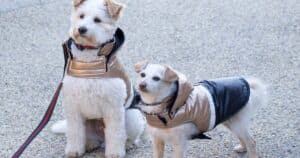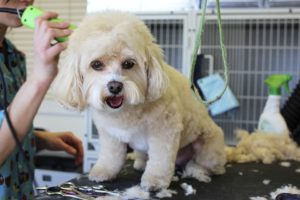
Does your dog have permanent red or brown stains and crusty fur around their eyes? These are known as tear stains, and they can make an otherwise well-groomed, happy dog look a little sad and sorry!
Stains can also appear around the mouth, or on your pet’s legs or belly if they chew their fur often.
Tears are supposed to be sucked up by the tear duct opening on the lower and upper eyelid and drained through the tear duct to the nose – that’s why you need to blow your nose when you cry! In dogs with tear staining on their face, the tears aren’t being directed to the nose and are instead spilling over onto the face, causing stains.
Some causes of the red tear stains associated with excessive tearing can include:
Depending on the severity of the underlying cause of your dog’s tear stains, surgery may be required to improve drainage. In milder cases, maintenance will suffice to keep their face clean and dry.
Less commonly, some dogs are born without a tear duct opening (I often see this in Cocker Spaniels) and surgery is required to correct the problem.
Another cause for tear staining may be overproduction of tears if something is irritating their eye, like pollen, wind and extra eyelashes (known as Dstichia).
If your dog has a mucky ocular discharge and especially if they are also squinting or rubbing their eye then take them to the vet ASAP to avoid any threat to vision.
Causes for this could include allergic conjunctivitis, dry eye, inflammation inside the eye (uveitis) and corneal ulcers.
When it comes to managing tear stains it’s important to keep the fur around your dog’s eyes short and combed out, along with using a safe and natural topical solution each day to wipe and then dry them.
Keeping the area clean and dry helps to prevent secondary bacterial and fungal infections.
Never use products containing peroxide or tooth whitening gel as these can irritate your dog’s eyes, instead opting for an effective, natural solution to help keep those stains at bay.
The DGG Tear Stain remover is Australian made and owned with soothing oat, chamomile and aloe vera. Ph balanced for dogs, it doesn’t contain any soap, bleach or other nasties, so check out their website for details.
About the Author: Dr Melissa Meehan is a highly experienced and respected veterinary surgeon with over 14 years experience. Dr Melissa obtained her Members in Small Animal Medicine through examination in 2008 and now runs her own veterinary ophthalmology service.

Winter safety for dogs – Top Tips


The importance of regular dog grooming

Treating skin allergies in dogs



Get your paws on Lara Shannon’s best selling books ‘Eat, Play, Love (your dog) and World of Dogs.
Available in Australia, USA, UK and Canada.